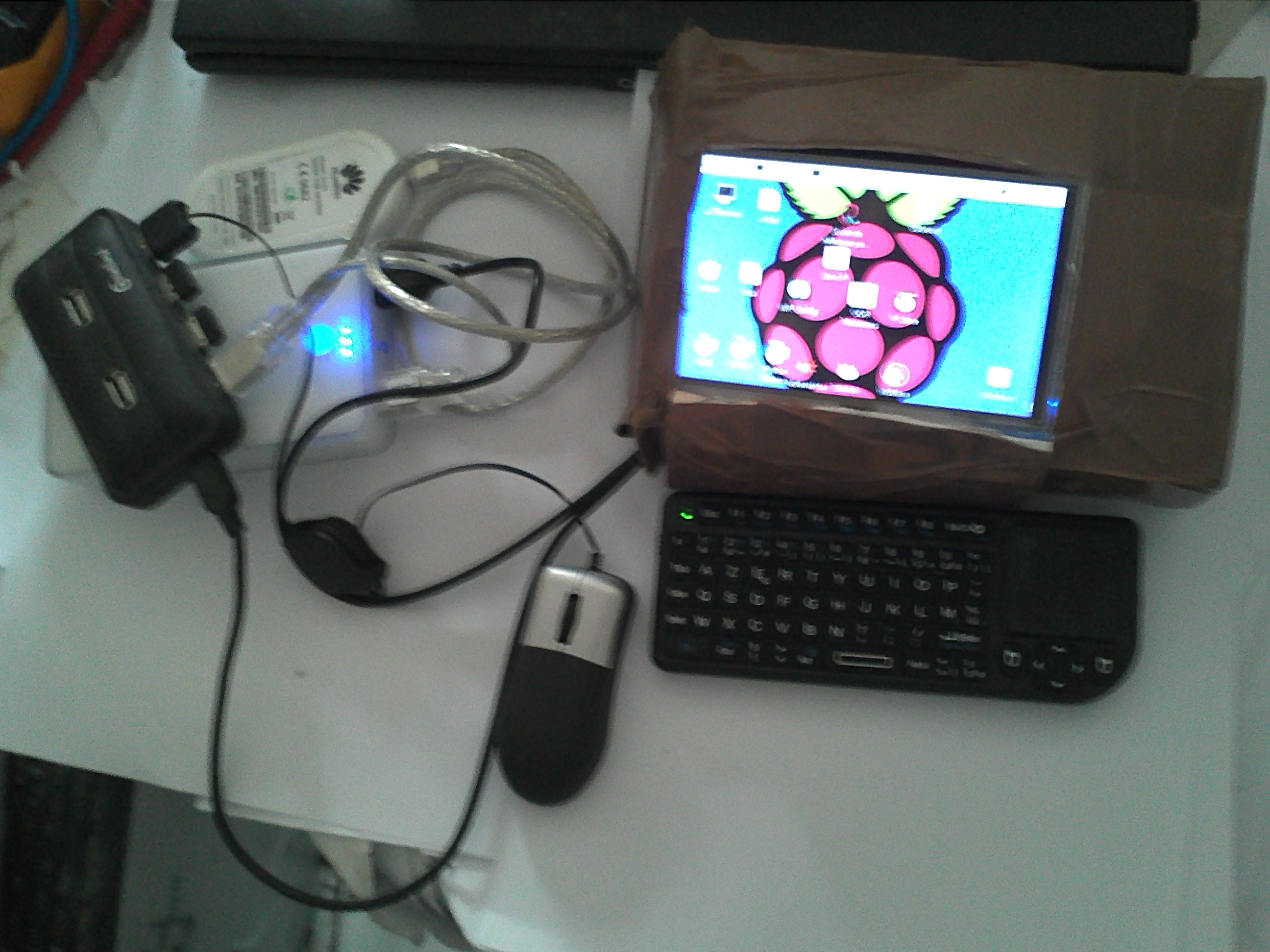
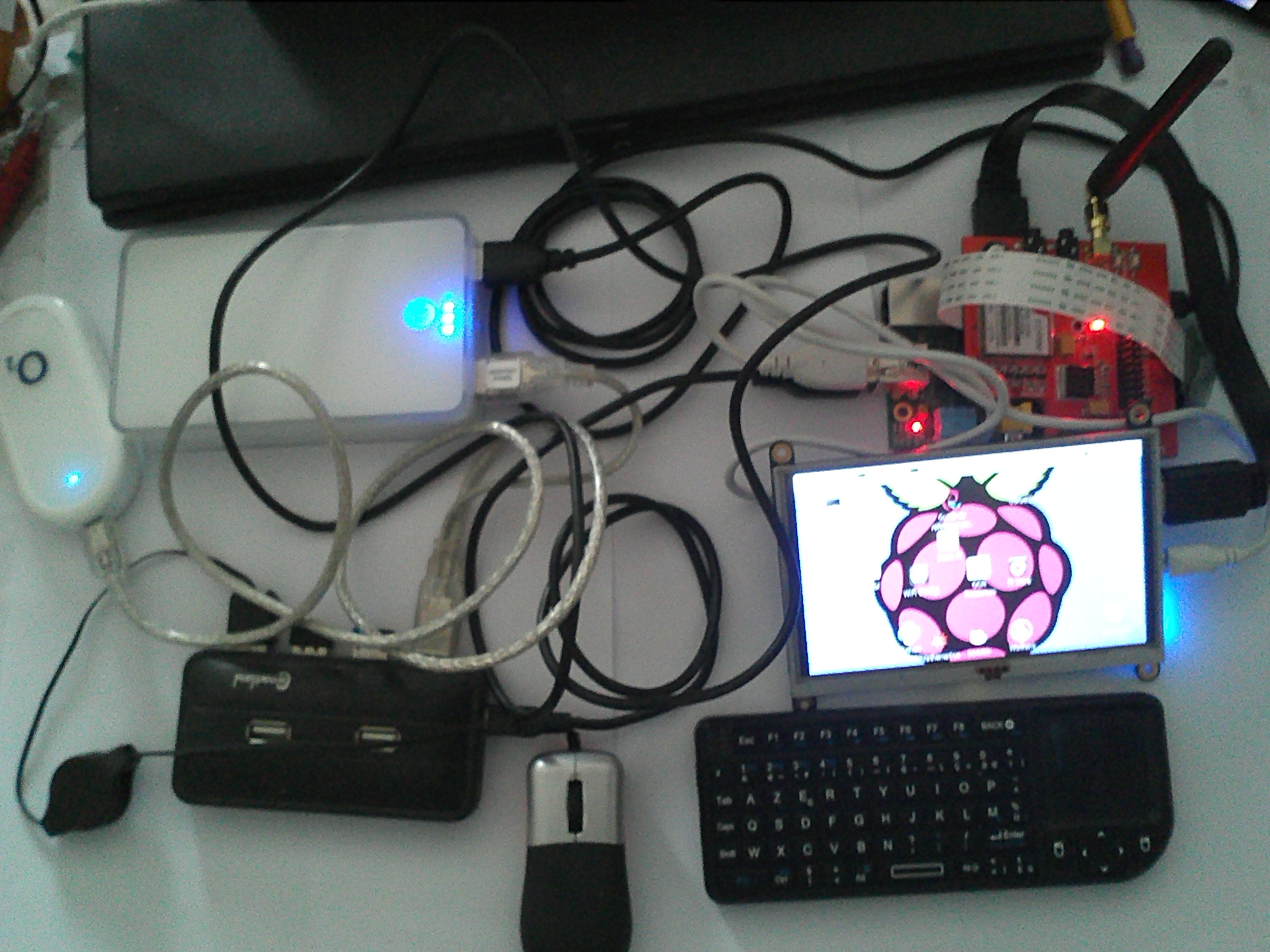
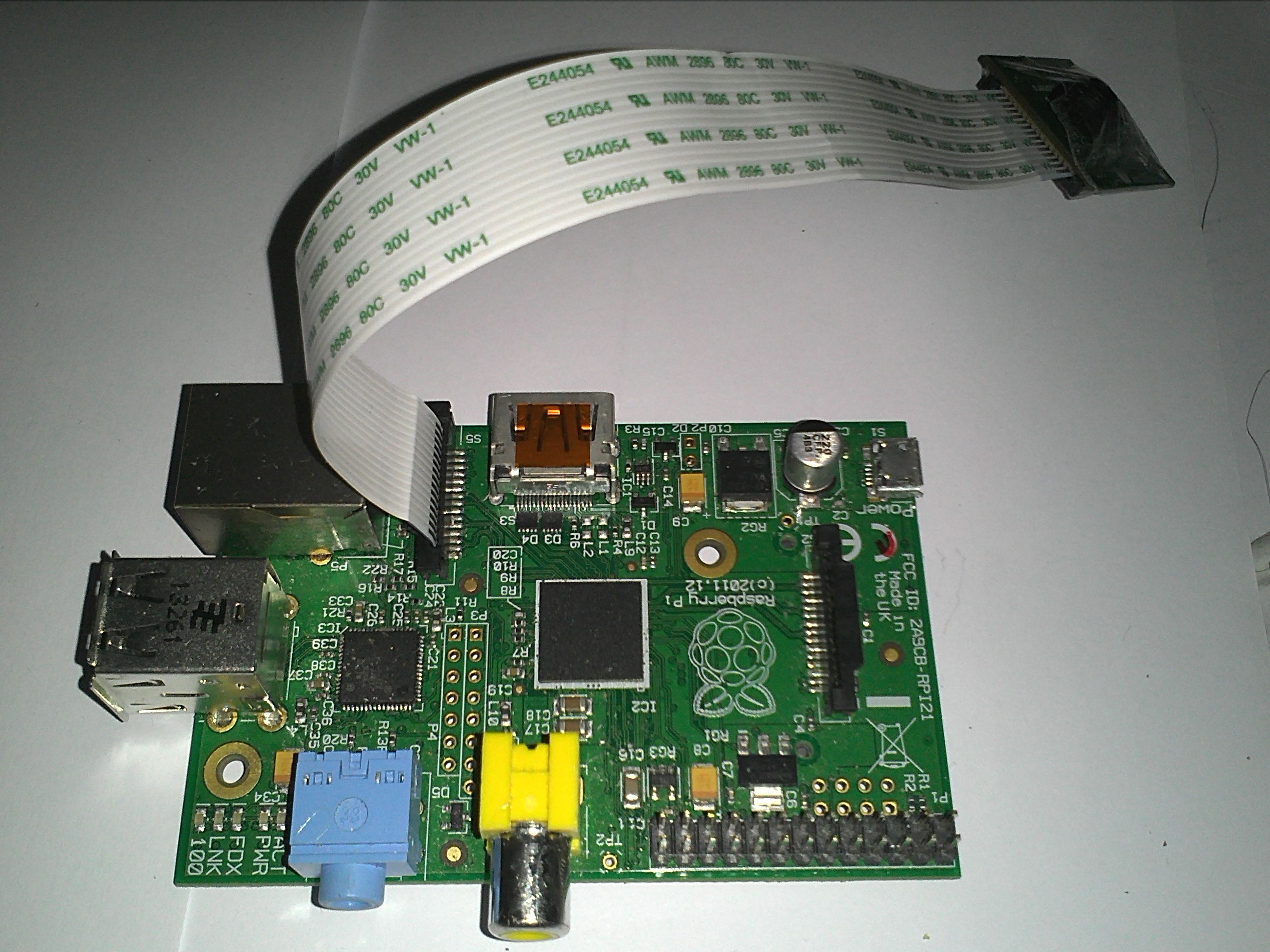

http://imall.iteadstudio.com/raspberry-pi-gsm-add-on.html

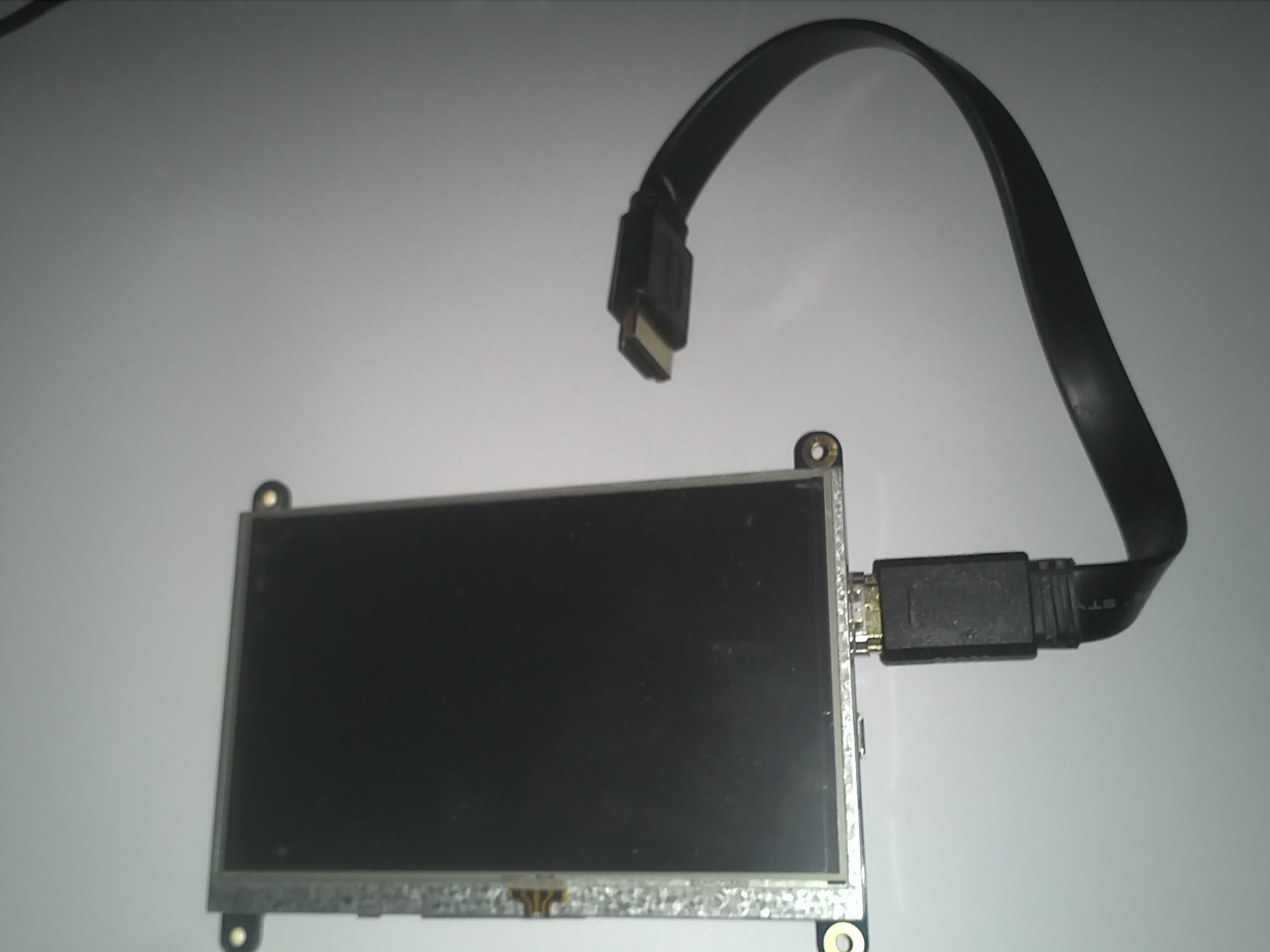
http://www.adafruit.com/products/2260


http://kubii.fr/modules-adafruit/379-pack-batterie-rpi-10000-mah-3272496001121.html




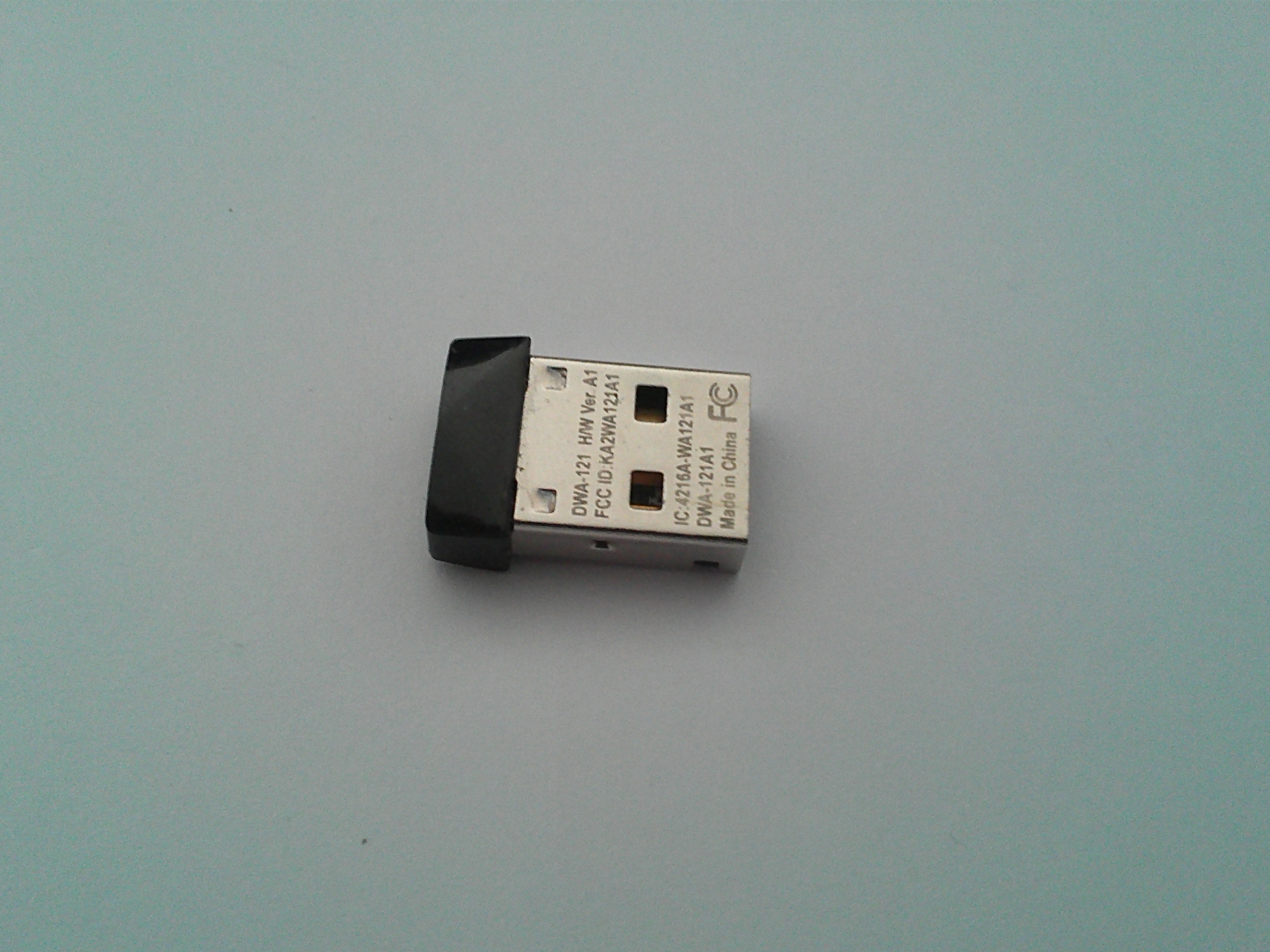
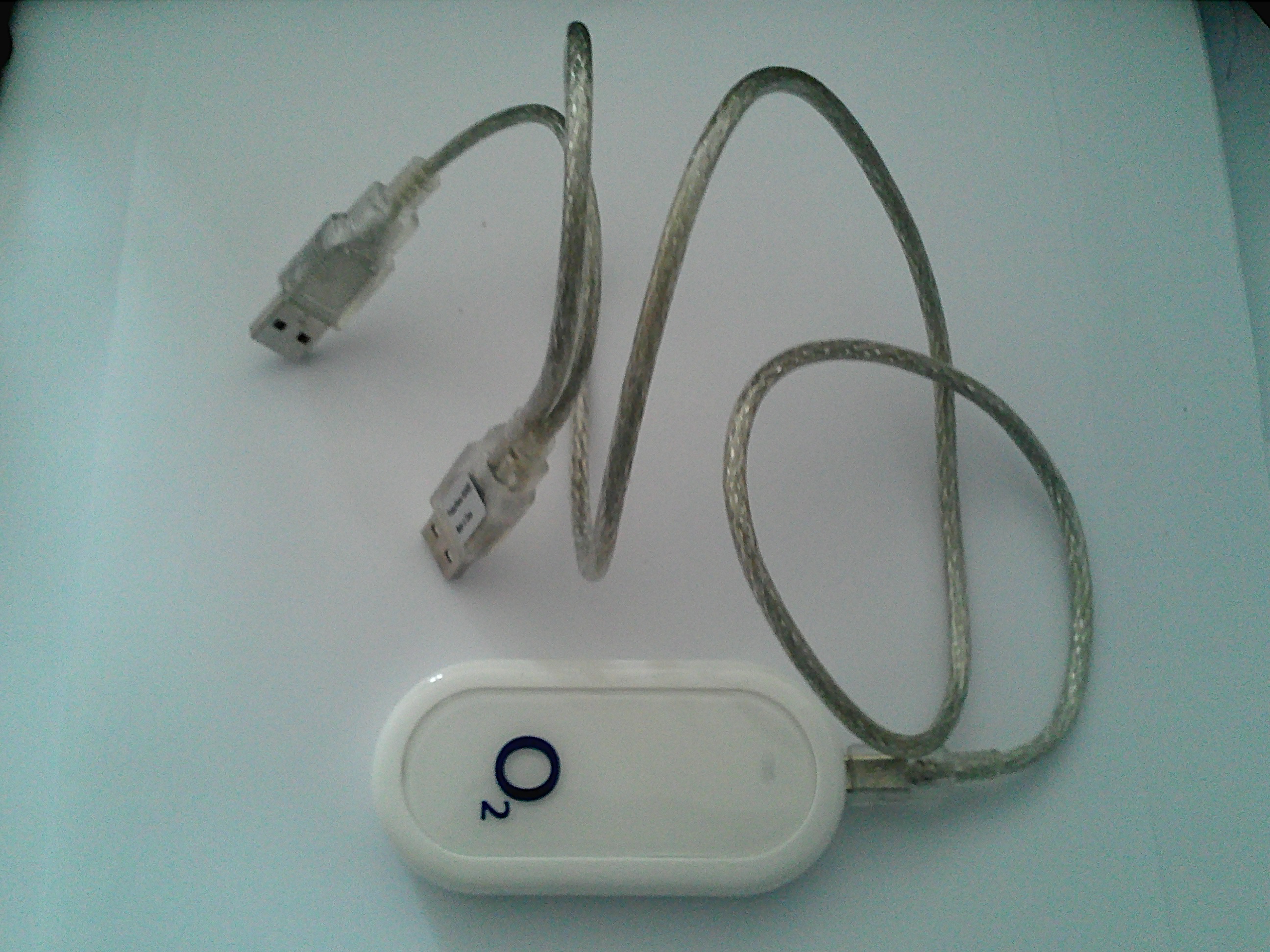


/etc/network/interfaces
auto lo iface lo inet loopback ### port ethernet de la carte ### adresse fixe pour réseau local # iface eth0 inet static # address 192.168.1.20 # netmask 255.255.255.0 ### ou adresse dhcp pour connexion a box internet auto eth0 allow-hotplug eth0 iface eth0 inet dhcp ### port ethernet USB iface eth1 inet dhcp ### wifi allow-hotplug wlan0 iface wlan0 inet dhcp wpa-ssid "myssid" wpa-psk "mypass" allow-hotplug ppp0 iface ppp0 inet dhcp
$ sudo sh -c "(echo nameserver 8.8.8.8 ; echo nameserver 8.8.4.4) >> /etc/resolv.conf"
$ sudo ip route replace default via 192?168.43.1 dev wlan0 $ sudo ifdown wlan0 $ sudo ifup wlan0
$ sudo apt-get install tightvncserver
#!/bin/sh
### BEGIN INIT INFO
# Provides: vncboot
# Required-Start: $remote_fs $syslog
# Required-Stop: $remote_fs $syslog
# Default-Start: 2 3 4 5
# Default-Stop: 0 1 6
# Short-Description: Start VNC server at boot time
# Description: Start VNC server at boot time.
### END INIT INFO
USER=root
HOME=/root
export USER HOME
VNCUSER='pi'
eval cd ~$VNCUSER
case "$1" in
start)
echo "Starting VNC Server for $VNCUSER"
su $VNCUSER -c '/usr/bin/tightvncserver :1'
;;
stop)
echo "Stopping VNC Server"
# /usr/bin/tightvncserver -kill :1
pkill Xtightvnc
;;
*)
echo "Usage: /etc/init.d/vncboot {start|stop}"
exit 1
;;
esac
exit 0
$ sudo chmod 755 /etc/init.d/vncboot $ sudo update-rc.d vncboot defaults
$ sudo nano /etc/inittab
1:2345:respawn:/sbin/getty --noclear 38400 tty1
# 1:2345:respawn:/sbin/getty --noclear 38400 tty1 1:2345:respawn:/bin/login -f pi tty1 /dev/tty1 2>&1
$ sudo raspi-config
Raspberry Pi camera board :
$ raspistill -o cam.jpg
$ fswebcam cam.jpg
http://www.cooking-hacks.com/documentation/tutorials/raspberry-pi-gprs-gsm-quadband-sim900
Connexion au modem :
$ minicom -b 115200 -D /dev/ttyAMA0
Command Response Description ------- -------- ----------- ATD*********; ********* is the number to call. ATA OK Answer an incoming call. ATH OK Cancel voice calls. AT+CMGF= OK Specifies the input and output format of the short messages. 0 for PDU mode and 1 for text mode. AT+CMGS Sends a message. AT+CMGR=* Reads a message. * is the number of the message. AT+SAPBR OK Configures GPRS profile. AT+FTPCID=1 OK Selects profile 1 for FTP. AT+FTPSERV=”****” OK Sets FTP server domain name or IP address. **** is the domain name or the IP. AT+FTPPORT=*** OK Sets FTP server port. *** is the port. AT+FTPUN=”***” OK Sets user name for FTP server access. *** is the user name. AT+FTPPW=”***” OK Sets password for FTP server access. *** is the password. AT+FTPPUTNAME="****" OK Sets destiny name for the file.*** is the name of the file. AT+FTPPUTPATH="****" OK Sets destiny file path. *** is the path of the file. AT+FTPPUT OK Use to put a file into the FTP server. AT+FTPGETNAME="****" OK Sets origin name for the file.*** is the name of the file. AT+FTPGETPATH="****" OK Sets origin file path. *** is the path of the file. AT+FTPGET Use to get a file into the FTP server. AT+CIPMUX= OK Selects single connection (0) or multiple connection (1) AT+CSTT="myAPN" OK Sets APN AT+CIICR Brings up wireless connection AT+CIFSR Get local IP address AT+CIPSTART Establishes a connection with a server. AT+CIPSEND Sends data when the a connection is established. AT+CIPCLOSE Closes the connection AT+SAPBR OK Configures GPRS profile AT+HTTPINIT OK Initializes HTTP service AT+HTTPPARA OK Configures HTTP parameters AT+HTTPACTION=0 OK Sets HTTP Method Action , GET in this chase. AT+HTTPREAD Reads HTTP data AT+HTTPTERM OK Closes the opened HTTP session.
/*
* Copyright (C) 2012 Libelium Comunicaciones Distribuidas S.L.
* http://www.libelium.com
*
* This program is free software: you can redistribute it and/or modify
* it under the terms of the GNU General Public License as published by
* the Free Software Foundation, either version 3 of the License, or
* (at your option) any later version.
*
* This program is distributed in the hope that it will be useful,
* but WITHOUT ANY WARRANTY; without even the implied warranty of
* MERCHANTABILITY or FITNESS FOR A PARTICULAR PURPOSE. See the
* GNU General Public License for more details.
*
* You should have received a copy of the GNU General Public License
* along with this program. If not, see .
*
* Version 0.1
* Author: Alejandro Gállego
*/
//Include ArduPi library
#include "arduPi.h"
void switchModule();
int led = 9;
int onModulePin = 2; // the pin to switch on the module (without press on button)
int timesToSend = 1; // Numbers of SMS to send
int count = 0;
char phone_number[]="0637127796"; // ********* is the number to call
void out (const char *s)
{
printf ("%s", s);
Serial.print (s);
}
void switchModule(){
digitalWrite(onModulePin,HIGH);
delay(2000);
digitalWrite(onModulePin,LOW);
}
void setup(){
// Serial.begin(115200); // UART baud rate
Serial.begin(19200);
delay(2000);
pinMode(led, OUTPUT);
pinMode(onModulePin, OUTPUT);
switchModule(); // switches the module ON
for (int i=0;i < 5;i++){
delay(5000);
}
// delay(5000);
out("AT+CMGF=1\r\n"); // sets the SMS mode to text
delay(100);
}
void loop(){
while (count < timesToSend){
delay(1500);
out("AT+CMGS=\""); // send the SMS number
out(phone_number);
out("\"\r\n");
while(Serial.read()!='>');
out("Hola caracola..."); // the SMS body
delay(500);
Serial.write(0x1A); //sends ++
Serial.write(0x0D);
Serial.write(0x0A);
printf("Sent.\n");
delay(5000);
count++;
}
}
int main (){
printf ("Setup...\n");
setup();
printf ("Loop...\n");
// while(1){
loop();
// }
return (0);
}
$ g++ -o send_sms send_sms.cpp arduPi.cpp -lrt $ sudo ./send_sms
Tutoriel : http://stackoverflow.com/questions/25301229/raspberry-pi-sim900-default-internet-access
Some notes before start:
Make sure the power supply you used for raspberrypi is exact 5V and it can provide at-least 2A current without voltage drop-out.The SIM900 power-source must be 3.3V 2A
Set the SIM900 baud rate to 115200 via: AT+IPR=115200
$ screen /dev/ttyAMA0 115200 type AT<enter> it will echo: OK. Hit ctrl+a k y to exit./etc/ppp/options-mobile
ttyAMA0
115200
lock
crtscts
modem
passive
novj
defaultroute
replacedefaultroute
noipdefault
usepeerdns
noauth
hide-password
persist
holdoff 10
maxfail 0
debug
Create the /etc/ppp/peers directory:
$ mkdir /etc/ppp/peers
$ cd /etc/ppp/peers
/etc/ppp/peers/mobile-auth
file /etc/ppp/options-mobile
user "your_usr"
password "your_pass"
connect "/usr/sbin/chat -v -t15 -f /etc/ppp/chatscripts/mobile-modem.chat"
/etc/ppp/peers/mobile-noauth
file /etc/ppp/options-mobile
connect "/usr/sbin/chat -v -t15 -f /etc/ppp/chatscripts/mobile-modem.chat"
Create the /etc/ppp/chatscripts directory:
$ mkdir /etc/ppp/chatscripts
/etc/ppp/chatscripts/mobile-modem.chat
ABORT 'BUSY'
ABORT 'NO CARRIER'
ABORT 'VOICE'
ABORT 'NO DIALTONE'
ABORT 'NO DIAL TONE'
ABORT 'NO ANSWER'
ABORT 'DELAYED'
REPORT CONNECT
TIMEOUT 6
'' 'ATQ0'
'OK-AT-OK' 'ATZ'
TIMEOUT 3
'OK' @/etc/ppp/chatscripts/pin
'OK\d-AT-OK' 'ATI'
'OK' 'ATZ'
'OK' 'ATQ0 V1 E1 S0=0 &C1 &D2 +FCLASS=0'
'OK' @/etc/ppp/chatscripts/mode
'OK-AT-OK' @/etc/ppp/chatscripts/apn
'OK' 'ATDT*99***1#'
TIMEOUT 30
CONNECT ''
/etc/ppp/chatscripts/my-operator-apn
AT+CGDCONT=1,"IP","<apn-name>"
/etc/ppp/chatscripts/pin.CODE
AT+CPIN=1234
/etc/ppp/chatscripts/pin.NONE
AT
/etc/ppp/chatscripts/mode.3G-only
AT\^SYSCFG=14,2,3fffffff,0,1
/etc/ppp/chatscripts/mode.3G-pref
AT\^SYSCFG=2,2,3fffffff,0,1
/etc/ppp/chatscripts/mode.GPRS-only
AT\^SYSCFG=13,1,3fffffff,0,0
/etc/ppp/chatscripts/mode.GPRS-pref
AT\^SYSCFG=2,1,3fffffff,0,0
- The SYSCFG line in the mode.* files is device-dependent, and likely Huawei-specific, So You may use the
mode.NONEfile if your modem is SIM900. *
/etc/ppp/chatscripts/mode.NONE
AT
Make some symbolic links:
$ ln -s /etc/ppp/chatscripts/my-operator-apn /etc/ppp/chatscripts/apn
$ ln -s /etc/ppp/chatscripts/mode.NONE /etc/ppp/chatscripts/mode
$ ln -s /etc/ppp/chatscripts/pin.NONE /etc/ppp/chatscripts/pin
If you have to enter credentials use mobile-auth
$ mv provider provider.example
$ ln -s /etc/ppp/peers/mobile-noauth /etc/ppp/peers/provider
Check syslog in another console:
$ tail -f /var/log/syslog | grep -Ei 'pppd|chat'
Finally issue the pon command to see the result:
$ pon
The base instruction : https://wiki.archlinux.org/index.php/3G_and_GPRS_modems_with_pppd
Attention ! Les fichiers de configuration contenant des commandes AT ne doivent pas contenir de ligne vide même à la fin.
$ ln -s /etc/ppp/peers/mobile-noauth /etc/ppp/peers/provider
AT+CGDCONT=1,"IP","ebouygtel.com"
$ ln -s /etc/ppp/chatscripts/bouygues-apn /etc/ppp/chatscripts/apn
file /etc/ppp/options-mobile user "orange" password "orange" connect "/usr/sbin/chat -v -t15 -f /etc/ppp/chatscripts/mobile-modem.chat"
$ ln -s /etc/ppp/peers/mobile-auth /etc/ppp/peers/provider
AT+CGDCONT=1,"IP","orange"
$ ln -s /etc/ppp/chatscripts/orange-apn /etc/ppp/chatscripts/apn
$ sudo pon $ plog
$ sudo poff
Pour les autres modèles de modems, vous pouvez trouver des informations ici : http://www.draisberghof.de/usb_modeswitch/device_reference.txt
Initialement le dongle est reconnu comme un CD-ROM contenant les fichiers de configuration pour Windows. Il faut donc le configurer pour qu'il soit reconnu comme un modem USB.
pi@raspberrypi ~ $ lsusb Bus 001 Device 007: ID 2357:f000 pi@raspberrypi ~ $
pi@raspberrypi ~ $ sudo apt-get install ppp usb-modeswitch wvdial
# Configuration for the usb_modeswitch package, a mode switching tool for # USB devices providing multiple states or modes # # Evaluated by the wrapper script /usr/sbin/usb_modeswitch_dispatcher # # To enable an option, set it to "1", "yes" or "true" (case doesn't matter) # Everything else counts as "disable" # Disable automatic mode switching globally (e.g. to access the original # install storage) DisableSwitching=0 # Enable logging (results in a extensive report file in /var/log, named # "usb_modeswitch_" and probably others EnableLogging=0 ####################################################### # TP-Link MA260 # # Contributor: Bjørn Mork DefaultVendor= 0x2357 DefaultProduct=0xf000 TargetVendor= 0x2357 TargetProduct= 0x9000 MessageContent="5553424312345678000000000000061b000000020000000000000000000000" #######################################################
pi@raspberrypi ~ $ sudo usb_modeswitch -W -c /etc/usb_modeswitch.conf pi@raspberrypi ~ $
# TP-Link MA260 ATTRS{idVendor}=="2357", ATTRS{idProduct}=="f000", RUN+="usb_modeswitch '%b/%k' -V 2357 -p 0xf000 -P 0x9000 -M "5553424312345678000000000000061b00000002000000000 0000000000000"LABEL="modeswitch_rules_end"# TP-Link MA260 ATTRS{idVendor}=="2357", ATTRS{idProduct}=="f000", RUN+="/usr/bin/eject -s %N"
pi@raspberrypi ~ $ sudo udevadm control --reload-rules pi@raspberrypi ~ $
pi@raspberrypi ~ $ lsusb (...) Bus 001 Device 007: ID 2357:9000 pi@raspberrypi ~ $ ls /dev/ttyUSB* /dev/ttyUSB0 /dev/ttyUSB1 /dev/ttyUSB2 pi@raspberrypi ~ $
Si l'identifiant produit reste à f000, tapez la commande :
pi@raspberrypi ~ $ sudo usb_modeswitch -v 2357 -p f000 -V 2357 -P 9000 -W -I -n -M '5553424312345678000000000000061e000000000000000000000000000000' -2 '5553424312345678000000000000061b000000020000000000000000000000'
pi@raspberrypi ~ $ su Mot de passe : root@raspberrypi:/home/pi# sudo modprobe -a option root@raspberrypi:/home/pi# echo "0x2357 0x9000" > /sys/bus/usb-serial/dirvers/option1/new_id root@raspberrypi:/home/pi# exit pi@raspberrypi ~ $
pi@raspberrypi ~ $ minicom -b 115200 -D /dev/ttyUSB2
Bienvenue avec minicom 2.6.1
OPTIONS: I18n
Compilé le Apr 28 2012, 19:24:31.
Port /dev/ttyUSB2
Tapez CTRL-A Z pour voir l'aide concernant les touches+------------------------------------+
| Quitter sans remettre à zéro ? |
AT | Oui Non |
OK +------------------------------------+
^AQ
pi@raspberrypi ~ $
Autre possibilité : connexion avec wvdial. Créer le fichier /etc/wvdial.conf avec le contenu suivant (exemple pour Orange, remplacez éventuellement l'username, le password et l'APN ebouygtel. par les paramètres correspondant à votre opérateur).
[Dialer Defaults] Modem Type = Analog Modem Stupid Mode = 1 ISDN = 0 New PPPD = yes Phone = *99# Modem = /dev/ttyUSB2 Username = 'orange'; Password = 'orange'; Baud = 460800 Init1 = ATZ Init2 = ATQ0 V1 E1 S0=0 &C1 &D2 +FCLASS=0 # Orange : Init3 = AT+CGDCONT=1,"IP","orange" #Init4 = AT$QCPDPP=1,1,"orange","orange" [Dialer pin] Modem Type = Analog Modem Stupid Mode = 1 ISDN = 0 New PPPD = yes Phone = *99# Modem = /dev/ttyUSB2 Baud = 460800 Init1 = AT+CPIN=0000
pi@raspberrypi /etc $ sudo wvdial --> WvDial: Internet dialer version 1.61 --> Initializing modem. --> Sending: ATZ ATZ OK --> Sending: ATQ0 V1 E1 S0=0 &C1 &D2 +FCLASS=0 ATQ0 V1 E1 S0=0 &C1 &D2 +FCLASS=0 OK --> Sending: AT+CGDCONT=1,"IP","orange" AT+CGDCONT=1,"IP","orange" OK --> Modem initialized. --> Sending: ATDT*99# --> Waiting for carrier. ATDT*99# CONNECT --> Carrier detected. Starting PPP immediately. --> Starting pppd at Thu Feb 5 13:44:01 2015 --> Pid of pppd: 5003 --> Using interface ppp0 --> pppd: 0y*[01] --> pppd: 0y*[01] --> pppd: 0y*[01] --> pppd: 0y*[01] --> pppd: 0y*[01] --> pppd: 0y*[01] --> local IP address 10.126.196.188 --> pppd: 0y*[01] --> remote IP address 10.64.64.64 --> pppd: 0y*[01] --> primary DNS address 192.168.10.110 --> pppd: 0y*[01]
pi@raspberrypi ~ $ ifconfig
(...)
ppp0 Link encap:Protocole Point-à-Point
inet adr:10.126.196.188 P-t-P:10.64.64.64 Masque:255.255.255.255
UP POINTOPOINT RUNNING NOARP MULTICAST MTU:1500 Metric:1
RX packets:8 errors:0 dropped:0 overruns:0 frame:0
TX packets:9 errors:0 dropped:0 overruns:0 carrier:0
collisions:0 lg file transmission:3
RX bytes:152 (152.0 B) TX bytes:209 (209.0 B)
(...)
pi@raspberrypi ~ $ sudo ip route replace default via 10.64.64.64 dev ppp0
pi@raspberrypi ~ $ ping www.google.fr
PING www.google.fr (173.194.66.94) 56(84) bytes of data.
64 bytes from we-in-f94.1e100.net (173.194.66.94): icmp_req=1 ttl=44 time=539 ms
64 bytes from we-in-f94.1e100.net (173.194.66.94): icmp_req=2 ttl=44 time=309 ms
64 bytes from we-in-f94.1e100.net (173.194.66.94): icmp_req=3 ttl=44 time=558 ms
^C
--- www.google.fr ping statistics ---
4 packets transmitted, 3 received, 25% packet loss, time 2999ms
rtt min/avg/max/mdev = 309.232/469.074/558.955/113.317 ms
pi@raspberrypi ~ $
pi@raspberrypi ~ $ lsusb (...) Bus 001 Device 006: ID 12d1:1003 Huawei Technologies Co., Ltd. E220 HSDPA Modem / E230/E270/E870 HSDPA/HSUPA Modem pi@raspberrypi ~ $ ls /dev/ttyUSB* /dev/ttyUSB0 /dev/ttyUSB1 pi@raspberrypi ~ $
Exemple de fichier /etc/wvdial.conf pour Huawei E220 avec Bouygues :
[Dialer Defaults] Modem Type = Analog Modem Stupid Mode = 1 ISDN = 0 New PPPD = yes Phone = *99# Modem = /dev/ttyUSB0 Username = 'guest'; Password = 'guest'; Baud = 460800 Init1 = ATZ Init2 = ATQ0 V1 E1 S0=0 &C1 &D2 +FCLASS=0 # Bouygues : Init3 = AT+CGDCONT=1,"IP","ebouygtel.com" #Init4 = AT$QCPDPP=1,1,"orange","orange" [Dialer pin] Modem Type = Analog Modem Stupid Mode = 1 ISDN = 0 New PPPD = yes Phone = *99# Modem = /dev/ttyUSB2 Baud = 460800 Init1 = AT+CPIN=0000
Voir :
$ sudo apt-get update && sudo apt-get install ca-certificates $ sudo apt-get install isc-dhcp-server $ sudo apt-get install hostapd bridge-utils iw $ sudo apt-get install dnsmasq
(...) allow-hotplug wlan0 iface wlan0 inet static address 192.168.42.1 netmask 255.255.255.0 #auto br0 #iface br0 inet dhcp # bridge_fd 1 # bridge_hello 3 # bridge_maxage 10 # bridge_stp off # bridge_ports ppp0 wlan0 pre-up iptables-restore < /etc/iptables.ipv4.nat
INTERFACES="wlan0"
(...)
# option domain-name "example.org";
# option domain-name-servers ns1.example.org, ns2.example.org;
(...)
authoritative;
(...)
subnet 192.168.42.0 netmask 255.255.255.0 {
range 192.168.42.10 192.168.42.50;
option broadcast-address 192.168.42.255;
option routers 192.168.42.1;
default-lease-time 600;
max-lease-time 7200;
option domain-name "local";
option domain-name-servers 8.8.8.8, 8.8.4.4;
interface wlan0;
}
$ cd /usr/sbin $ sudo mv hostapd hostapd_std $ sudo wget http://dl.dropbox.com/u/1663660/hostapd/hostapd (...) $ sudo chown root:root hostapd $ sudo chmod 755 hostapd
DAEMON_CONF="/etc/hostapd/hostapd.conf"
interface=wlan0 bridge=br0 driver=rtl871xdrv country_code=FR ctrl_interface=wlan0 ctrl_interface_group=0 ssid=RPiAP hw_mode=g channel=1 #wpa=3 #wpa_passphrase=PASSWORD #wpa_key_mgmt=WPA-PSK #wpa_pairwise=TKIP #rsn_pairwise=CCMP beacon_int=100 #auth_algs=3 auth_algs=1 macaddr_acl=0 wmm_enabled=1 eap_reauth_period=360000000
Tapez ensuite les commandes suivantes pour créer les tables de routage :
$ sudo sh -c "echo 1 > /proc/sys/net/ipv4/ip_forward" $ sudo iptables -t nat -A POSTROUTING -o eth0 -j MASQUERADE $ sudo iptables -A FORWARD -i eth0 -o wlan0 -m state --state RELATED,ESTABLISHED -j ACCEPT $ sudo iptables -A FORWARD -i wlan0 -o eth0 -j ACCEPT $ sudo sh -c "iptables-save > /etc/iptables.ipv4.nat"
Tapez "ifconfig" et si l'adresse ip n'apparait pas pour wlan0, redémarrez wlan0 avec "sudo ifdown wlan0 && sudo ifup wlan0".
Connectez le modem Wifi (voir "Connexion internet avec un modem USB Huawei E220").
Démarrez les services :
$ sudo service isc-dhcp-server restart $ sudo sysctl -w net.ipv4.ip_forward=1 $ sudo iptables -t nat -A POSTROUTING -j MASQUERADE $ sudo hostapd -d /etc/hostapd/hostapd.conf
Vous pouvez créer un script de démarrage /ur/local/bin/hotspot :
#!/bin/sh echo "Restarting wlan0..." ifdown wlan0 ifup wlan0 echo "Restarting DHCP server..." service isc-dhcp-server restart echo "Forwarding..." sysctl -w net.ipv4.ip_forward=1 iptables -t nat -A POSTROUTING -j MASQUERADE echo "Starting access point..." hostapd -d /etc/hostapd/hostapd.conf >/dev/null 2>/dev/null & echo "Done."
$ sudo chmod a+rx /usr/local/bin/hotspot
1. Install the necessary software. sudo apt-get install hostapd udhcpd 2. Configure DHCP. Edit the file /etc/udhcpd.conf and configure it like this: start 192.168.42.2 # This is the range of IPs that the hostspot will give to client devices. end 192.168.42.20 interface wlan0 # The device uDHCP listens on. remaining yes opt dns 8.8.8.8 4.2.2.2 # The DNS servers client devices will use. opt subnet 255.255.255.0 opt router 192.168.42.1 # The Pi's IP address on wlan0 which we will set up shortly. opt lease 864000 # 10 day DHCP lease time in seconds Edit the file /etc/default/udhcpd and change the line: DHCPD_ENABLED="no" to #DHCPD_ENABLED="no" You will need to give the Pi a static IP address with the following command: sudo ifconfig wlan0 192.168.42.1 To set this up automatically on boot, edit the file /etc/network/interfaces and replace the line "iface wlan0 inet dhcp" to: iface wlan0 inet static address 192.168.42.1 netmask 255.255.255.0 If the line "iface wlan0 inet dhcp" is not present, add the above lines to the bottom of the file. Change the lines (they probably won't all be next to each other): allow-hotplug wlan0 wpa-roam /etc/wpa_supplicant/wpa_supplicant.conf iface default inet manual to: #allow-hotplug wlan0 #wpa-roam /etc/wpa_supplicant/wpa_supplicant.conf #iface default inet dhcp 3. Configure HostAPD. You can create an open network, or a WPA-secured network. A secure network is recommended to prevent unauthorized use and tampering, but you can also create an open network. To create a WPA-secured network, edit the file /etc/hostapd/hostapd.conf (create it if it doesn't exist) and add the following lines: interface=wlan0 driver=nl80211 ssid=My_AP hw_mode=g channel=6 macaddr_acl=0 auth_algs=1 ignore_broadcast_ssid=0 wpa=2 wpa_passphrase=My_Passphrase wpa_key_mgmt=WPA-PSK wpa_pairwise=TKIP rsn_pairwise=CCMP Change ssid=, channel=, and wpa_passphrase= to values of your choice. SSID is the hotspot's name which is broadcast to other devices, channel is what frequency the hotspot will run on, wpa_passphrase is the password for the wireless network. For many, many more options see the file /usr/share/doc/hostapd/examples/hostapd.conf.gz If you would like to create an open network, put the following text into /etc/hostapd/hostapd.conf: interface=wlan0 ssid=My_AP hw_mode=g channel=6 auth_algs=1 wmm_enabled=0 Change ssid= and channel= to values of your choice. Note that anyone will be able to connect to your network, which is generally not a good idea. Also, some regions will hold an access point's owner responsible for any traffic that passes though an open wireless network, regardless of who actually caused that traffic. Edit the file /etc/default/hostapd and change the line: #DAEMON_CONF="" to: DAEMON_CONF="/etc/hostapd/hostapd.conf" 4. Configure NAT (Network Address Translation). NAT is a technique that allows several devices to use a single connection to the internet. Linux supports NAT using Netfilter (also known as iptables) and is fairly easy to set up. First, enable IP forwarding in the kernel: sudo sh -c "echo 1 > /proc/sys/net/ipv4/ip_forward" To set this up automatically on boot, edit the file /etc/sysctl.conf and add the following line to the bottom of the file: net.ipv4.ip_forward=1 Second, to enable NAT in the kernel, run the following commands: sudo iptables -t nat -A POSTROUTING -o eth0 -j MASQUERADE sudo iptables -A FORWARD -i eth0 -o wlan0 -m state --state RELATED,ESTABLISHED -j ACCEPT sudo iptables -A FORWARD -i wlan0 -o eth0 -j ACCEPT These instructions don't give a good solution for rerouting https and for URLs referring to a page inside a domain, like www.nu.nl/38274.htm. The user will see a 404 error. Your Pi is now NAT-ing. To make this permanent so you don't have to run the commands after each reboot, run the following command: sudo sh -c "iptables-save > /etc/iptables.ipv4.nat" Now edit the file /etc/network/interfaces and add the following line to the bottom of the file: up iptables-restore < /etc/iptables.ipv4.nat 5. Fire it up! Run the following commands to start the access point: sudo service hostapd start sudo service udhcpd start Your Pi should now be hosting a wireless hotspot. To get the hotspot to start on boot, run these additional commands: sudo update-rc.d hostapd enable sudo update-rc.d udhcpd enable At the completion of these instructions, your Pi should be providing a wireless network and allowing other devices to connect to the Internet. From my experience, the Pi makes a decent access point, although with cheaper WiFi dongles range will be fairly limited. I haven't stress tested this setup, but it seems to work fairly well and is handy when a "real" access point isn't available. I wrote most of the instructions from memory, if you find any errors/typos I'll correct them.
#!/bin/sh iptables -F iptables -t nat -F iptables -t mangle -F iptables -A FORWARD -i wlan0 -o ppp0 -j DROP iptables -t nat -I PREROUTING -i wlan0 -p tcp --dport 80 -j DNAT --to-destination 192.168.42.1:80 iptables -t nat -I PREROUTING -i wlan0 -p tcp --dport 443 -j DNAT --to-destination 192.168.42.1:443 iptables -t nat -I PREROUTING -i wlan0 -p udp --dport 53 -j DNAT --to-destination 192.168.42.1:53 iptables -t mangle -N internet iptables -t mangle -A PREROUTING -i wlan0 -p tcp -m tcp --dport 80 -j internet iptables -t mangle -A internet -j MARK --set-mark 99 iptables -t nat -A PREROUTING -i wlan0 -p tcp -m mark --mark 99 -m tcp --dport 80 -j DNAT --to-destination 192.168.42.1 service hostapd restart service dnsmasq restart
 | |
 | |
 | Raspberry Pi B avec module caméra |
 | Carte modem GSM SIM900 http://imall.iteadstudio.com/raspberry-pi-gsm-add-on.html |
 | Carte micro SD avec système Raspbian et adaptateur SD |
 | Ecran tactile 5'' http://www.adafruit.com/products/2260 |
 | Cable USB pour raccorder l'écran au Raspberry Pi |
 | Batterie http://kubii.fr/modules-adafruit/379-pack-batterie-rpi-10000-mah-3272496001121.html |
 | Cable USB alimentation |
 | Hub USB |
 | Clavier sans fil avec dongle et cable recharge |
 | Souris |
 | Dongle Wifi RTL8188CUS |
 | Modem 3G Huawei E220 |
 | Adaptateur audio USB et casque |
 | Boite en carton et ruban adhésif |